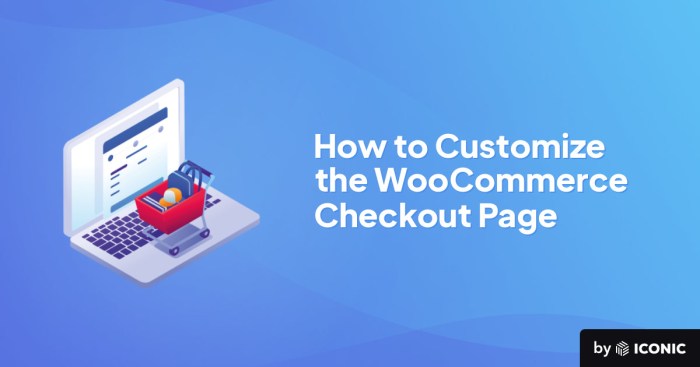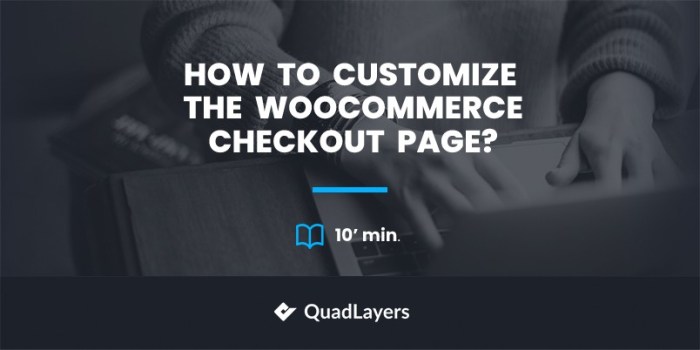The WooCommerce checkout page is a crucial element of your online store. A poorly designed checkout process can lead to abandoned carts and lost revenue. Conversely, a streamlined and user-friendly checkout experience can significantly boost conversions. This comprehensive guide will walk you through various methods to customize your WooCommerce checkout page, enhancing both its functionality and aesthetics.
Understanding the WooCommerce Checkout Process
Before diving into customization, it’s vital to understand the default WooCommerce checkout flow. This involves several key steps:

Source: iconicwp.com
- Returning Customer Login/Registration: Existing customers can log in, while new customers can create an account.
- Billing Address: Customers enter their billing address information.
- Shipping Address: Customers enter their shipping address (optional if shipping isn’t required).
- Shipping Method Selection: Customers choose their preferred shipping method based on available options.
- Payment Method Selection: Customers select their preferred payment gateway (e.g., PayPal, Stripe, credit card).
- Order Review: Customers review their order summary before proceeding to payment.
- Order Placement: Customers complete the purchase.
- Order Confirmation: Customers receive an order confirmation email.
Customizing this process involves modifying various aspects, from the visual layout to the functionality of specific fields.
Methods for Customizing Your WooCommerce Checkout Page
There are several approaches to customizing your WooCommerce checkout page, ranging from simple plugin integrations to advanced code modifications. Let’s explore the most effective methods:
1. Using WooCommerce Checkout Page Plugins
Several plugins offer easy-to-use interfaces for customizing the checkout page without requiring coding skills. Popular options include:
- Checkout Field Editor: This plugin allows you to add, remove, and rearrange checkout fields. You can customize field labels, descriptions, and even add custom validation rules. Checkout Field Editor Plugin
- WooCommerce Checkout Manager: This plugin offers extensive customization options, including the ability to reorder fields, hide fields, and add custom fields. WooCommerce Checkout Manager Plugin (Note: This may require a paid version for full functionality)
- YITH WooCommerce Checkout Manager: Similar to the above, this plugin provides a user-friendly interface for managing and customizing checkout fields. YITH WooCommerce Checkout Manager Plugin (Note: This may require a paid version for full functionality)
These plugins are excellent for beginners and those who want to avoid directly modifying code. They offer a visual interface for making changes, reducing the risk of errors.
2. Customizing with CSS
For more granular control over the visual appearance of your checkout page, you can use custom CSS. This involves adding CSS code to modify elements like colors, fonts, spacing, and layout. You can add custom CSS through your theme’s customizer or by creating a child theme for better maintainability. Remember to always back up your website before making any code changes.
Example: To change the background color of the checkout page, you might add the following CSS:
.woocommerce-checkout background-color: #f2f2f2;
3. Using WooCommerce Hooks and Filters
For more advanced customizations, you can leverage WooCommerce’s hooks and filters. These allow you to add or modify functionality within the checkout process. This requires a basic understanding of PHP and WooCommerce’s code structure. Examples include adding custom fields, modifying the order of fields, or adding custom messages.
Example (Adding a custom field): This would involve using the `woocommerce_after_order_notes` hook to add a custom field after the order notes section. This requires adding code to your theme’s `functions.php` file or a custom plugin.
4. Child Themes and Theme Customization
Creating a child theme is a best practice when making any modifications to your WordPress theme. This ensures that your changes are preserved even after theme updates. Many themes offer customization options within their theme customizer, allowing you to modify aspects of the checkout page without coding. Check your theme’s documentation for specific customization options.
Optimizing Your WooCommerce Checkout Page for Conversions
Beyond customization, optimizing your checkout page for conversions is crucial. Consider these best practices:
- Minimize Fields: Only request essential information. Too many fields can lead to cart abandonment.
- Clear and Concise Language: Use clear and concise language throughout the checkout process.
- Progress Indicators: Show customers their progress through the checkout process.
- Guest Checkout Option: Offer a guest checkout option for convenience.
- Secure Payment Gateways: Use reputable and secure payment gateways to build trust.
- Mobile Responsiveness: Ensure your checkout page is fully responsive and works seamlessly on all devices.
- Trust Badges: Display trust badges (e.g., SSL certificate, payment gateway logos) to build confidence.
- Clear Call to Actions (CTAs): Use clear and compelling CTAs to guide customers through the process.
Frequently Asked Questions (FAQ)
- Q: Can I completely redesign my WooCommerce checkout page? A: While you can significantly customize the checkout page’s appearance and functionality, completely redesigning it from scratch typically requires significant coding expertise and might break core WooCommerce functionality.
- Q: How do I add a custom field to my checkout page? A: You can add custom fields using plugins like Checkout Field Editor or by using WooCommerce hooks and filters (requires coding).
- Q: How can I improve my checkout page’s conversion rate? A: Focus on minimizing fields, using clear language, providing progress indicators, and offering a guest checkout option. Ensure mobile responsiveness and display trust badges.
- Q: What are the risks of directly modifying WooCommerce core files? A: Directly modifying core files can lead to issues during updates. Your changes will be overwritten, potentially breaking your website’s functionality. Always use child themes and custom plugins.
- Q: Where can I find more information about WooCommerce hooks and filters? A: The official WooCommerce documentation is an excellent resource: WooCommerce Documentation
Conclusion
Customizing your WooCommerce checkout page is a crucial step in optimizing your online store’s conversion rate. By using the methods Artikeld in this guide, you can create a seamless and user-friendly checkout experience that encourages customers to complete their purchases. Remember to always back up your website before making any significant changes.

Source: quadlayers.com
Call to Action
Ready to transform your WooCommerce checkout page? Start exploring the plugins and techniques discussed above, and watch your conversions soar!
Quick FAQs
Can I customize the checkout page without coding?
Yes, many plugins offer extensive customization options without requiring code changes. These plugins often provide visual editors and pre-built templates.
How do I add a custom field to the checkout page?
This typically involves using a plugin or, for advanced users, directly modifying the checkout page template files. Ensure the added field is relevant and doesn’t unnecessarily complicate the checkout process.
What are the best practices for checkout page design?
Prioritize clarity, simplicity, and a mobile-friendly layout. Minimize distractions, use clear calls to action, and ensure all fields are clearly labeled.
How can I improve checkout page speed?
Optimize images, minimize plugins, use a caching plugin, and leverage a content delivery network (CDN) to improve page load times.